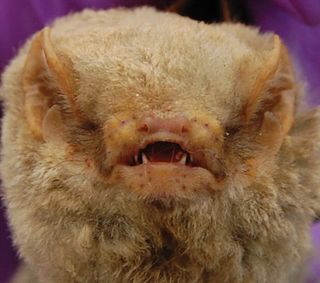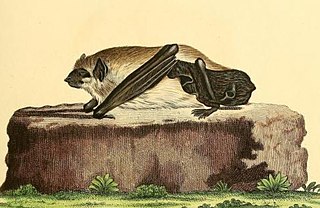
Vespertilionidae is a family of microbats, of the order Chiroptera, flying, insect-eating mammals variously described as the common, vesper, or simple nosed bats. The vespertilionid family is the most diverse and widely distributed of bat families, specialised in many forms to occupy a range of habitats and ecological circumstances, and it is frequently observed or the subject of research. The facial features of the species are often simple, as they mainly rely on vocally emitted echolocation. The tails of the species are enclosed by the lower flight membranes between the legs. Over 300 species are distributed all over the world, on every continent except Antarctica. It owes its name to the genus Vespertilio, which takes its name from a word for bat, vespertilio, derived from the Latin term vesper meaning 'evening'; they are termed "evening bats" and were once referred to as "evening birds".

Bate's slit-faced bat is a species of slit-faced bat frequently confused with Nycteris major. It is broadly distributed and common, living throughout many parts of Africa in forests and savannas.

Allen's striped bat is a species of bat in the family Vespertilionidae, the vesper bats. It is native to Africa, where it occurs in Cameroon and the Democratic Republic of the Congo. This species can be found in lowland tropical moist forests. Little else is known about it.

The silvered bat is a species of vesper bat in the family Vespertilionidae. It is found in Angola, Burundi, Cameroon, Republic of the Congo, Democratic Republic of the Congo, Equatorial Guinea, Kenya, Malawi, Rwanda, and Tanzania. Its natural habitats are subtropical or tropical moist lowland forests and moist savanna.

Beatrix's bat is a species of vesper bat in the family Vespertilionidae. It can be found in Angola, Central African Republic, Democratic Republic of the Congo, Ivory Coast, Equatorial Guinea, Gabon, Ghana, Kenya, and Nigeria. It is found in subtropical or tropical moist lowland forests.
The Bibundi bat is a species of vesper bat in the family Vespertilionidae. It can be found in Cameroon, Republic of the Congo, Uganda, and the Dzanga-Sangha Special Reserve.

The Abo bat is a species of vesper bat in the family Vespertilionidae. It is found in several countries in West Africa and Central Africa. It is found in subtropical and tropical dry and moist lowland forests.
The variegated butterfly bat is a species of vesper bat. It is sometimes also called the leaf-winged bat, or simply the butterfly bat. It is not currently endangered, but may be threatened by habitat loss in some parts of its range.
Curry's bat is a species of vesper bat in the family Vespertilionidae. It is found in Cameroon and Democratic Republic of the Congo. Its natural habitats are subtropical and tropical moist lowland forests and subtropical and tropical swamps.

Schreber's yellow bat or the giant house bat, is a species of vesper bat. It is found in Benin, Democratic Republic of the Congo, Ivory Coast, Ghana, Kenya, Malawi, Mozambique, Nigeria, Senegal, Tanzania, Togo, and Zimbabwe. Its natural habitats are subtropical or tropical moist lowland forests, dry savanna, and moist savanna. It is an uncommon species and its biology is poorly known. It was first described in 1774 by the German naturalist Johann Christian Daniel von Schreber, who named it Vespertilio nigrita. It was later transferred to the genus Scotophilus, making it Scotophilus nigrita.

Anchieta's serotine, formerly known as Anchieta's pipistrelle, is a species of vesper bat. It is found in Angola, Democratic Republic of the Congo, South Africa, Zambia, Zimbabwe and Madagascar. The species inhabits savanna habitats.
The broad-headed serotine, formerly known as the broad-headed pipistrelle, is a species of vesper bat in the family Vespertilionidae. It is found in Angola, Cameroon, Republic of the Congo, Democratic Republic of the Congo, Ivory Coast, Guinea, liberia, Kenya, South Sudan, and Uganda. Its natural habitats are subtropical and tropical forests.

The lesser woolly bat is a species of vesper bat in the family Vespertilionidae. It is found in Botswana, Central African Republic, Democratic Republic of the Congo, Ivory Coast, Ethiopia, Gabon, Ghana, Guinea, Kenya, Liberia, Malawi, Nigeria, South Africa, Tanzania, Zambia, Zimbabwe and rarely Ethiopia. Its natural habitats are subtropical or tropical moist lowland forests, dry savanna, and moist savanna. Members of this species typically have a dark greyish brown fur with whitish tips scattered throughout.
The lesser long-fingered bat, also known as the black clinging bat or lesser bent-winged bat, is a species of vesper bat in the family Vespertilionidae. It is found in western Southern Africa, south East Africa, and parts of Central Africa. Its natural habitats are temperate forests, temperate shrubland, and caves and other subterranean habitats.

The Cape serotine is a species of vesper bat occurring in Sub-Saharan Africa. 'Serotine' is from Latin 'serotinus' meaning ‘of the evening'.

The Egyptian tomb bat is a species of sac-winged bat in the family Emballonuridae. It is a medium- to large-sized microbat with a mass of approximately 30 g (1.1 oz). It is an aerial insectivore, foraging in open space. Based on individuals captured in Ethiopia, it is thought to feed predominantly on Lepidoptera, but is also known to feed on Isoptera, Coleoptera and Orthoptera.

The Mongalla free-tailed bat is a species of bat in the family Molossidae. It is found in Burkina Faso, Cameroon, Democratic Republic of the Congo, Ivory Coast, Ghana, Kenya, Mali, Sudan, and Uganda. Its natural habitats are dry savanna, moist savanna, and subtropical or tropical seasonally wet or flooded lowland grassland.

Glauconycteris is a genus of vespertilionid bats found in Africa.

Eptescini is a tribe of bats in the family Vespertilionidae. This tribe has a cosmopolitan distribution.















